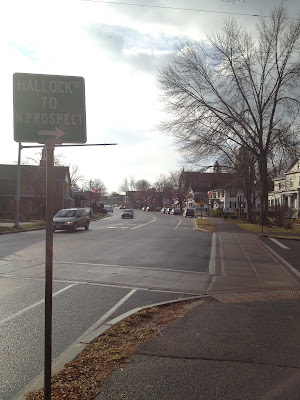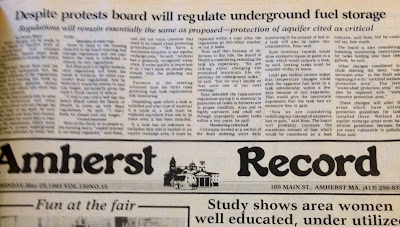3rd tank, also with one foot of the volatile liquid remaining, was buried along eastern side of building
The old expression "bad things come in threes" certainly played out over the past week for a small business located at the highly visible intersection of Main/Triangle/Dickinson Street just below the Emily Dickinson Museum .
The
first underground storage tank, resembling a large aerial bomb dropped from a B52, was bad enough considering it lay almost directly under the main entry immediately in front of the building.
Assistant Fire Chief Don McKay was instantly suspicious there would be a second
due to a large connecting pipe visible on top of the tank, which sure enough proved accurate. The third tank alongside the building came as more of a surprise, kind of like the initial discovery.
The first gas pump appeared in Amherst in 1905 on the corner of Kellogg Avenue planted there by Melrose Paige. Probably installed properly, since Mr. Paige went on to become Amherst Fire Department Call Chief in 1911, and by 1925 he was Chair of the Amherst Select Board.
At first, no permit or license was required to sell gasoline, although this being Amherst, regulation soon followed. The first license to sell gasoline was recorded at the Town Clerk
's office in May, 1914.
By the late 1930s Amherst hosted 24 "filling stations" and the citizens did not want a 25th. At a routine Monday night Select Board meeting in July of 1939, eighteen citizens turned out for a public hearing to protest a gas station permit for a proposed business (by a large oil company) on North Pleasant Street.
Their battle cry was a simple but inflammatory one: North Pleasant Street, the busiest commercial street in Amherst, should not become "gasoline alley".
The Select Board denied the permit.
The building on Main Street where the underground tanks were just discovered is located very near Classic Chevrolet, formerly Paige's Chevrolet, founded in 1883 -- the first auto service business in Amherst.
Patterson's Garage, Main Street Amherst circa 1940
Prior to becoming a pizza shop it was an entrenched location for auto service: Ledoyt's Garage shows up in 1923, two years later becoming Bilger's Garage, and in 1936 Main Street Garage. Between 1940-1950 the location was operated as Patterson's Garage and, finally, Dick's Auto Service operated by Dick Stedman.
Amherst Record ad 11/28/1963
A valve fitting found on one of the tanks was manufactured by the Evertite Corporation, a business established in 1935, indicating that Main Street Garage is probably responsible for the tanks -- although they could have gone in years earlier and were added to or replaced after 1935.
Now of course the explosive question: how many
more large underground tanks, with gasoline still in them, remain buried and forgotten around town?
####
The tanks, measuring 5 feet in diameter and 16 feet long, were peeled open after a chemical solution poured in to neutralize explosive fumes, siphoned, and then replaced with an equal amount of concrete. Old gas was taken to a "waste burning facility" by New England Environmental, Inc so it did not completely go to, err, waste.
Board of Health regulations banning underground tanks in the aquifer recharge zones was a volatile issue in 1983, vociferously protested by local farmers, gas stations owners and others with underground tanks. Those who, according to then Board of Health Chair Davis Ross, "had a vested interest in not being regulated."








































